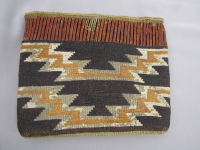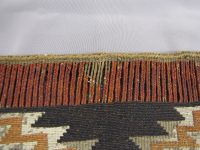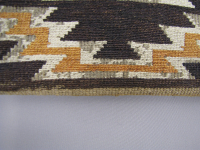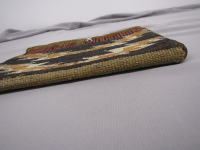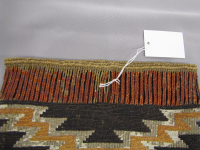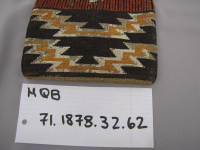gaya:ˀ bag, pouch
gaya:ˀ bag, pouch
gaya:ˀ bag, pouch
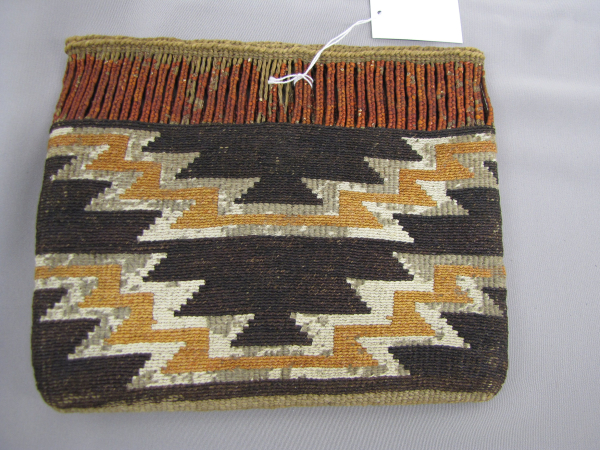
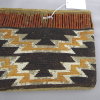
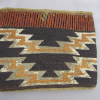
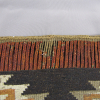
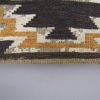
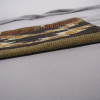
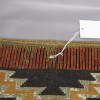
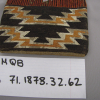
This relative, a twined gaya:ˀ, bag, pouch, is elaborated with dyed moosehair in geometric motifs. Possibly of Huron-Wendat origin and dates from the eighteenth century.
This relative currently resides in the musée du quai Branly.
MQB museum catalogue. A pouch in the British Museum that is very similar (GKS #26695, catalogue #AM,SLMisc.203) was made by the Huron-Wendat and was acquired by the Sir Hans Sloane in 1725.
The Huron-Wendat or Haudenausaunee peoples of the Eastern Great Lakes were known to have used these techniques to make pouches.
Museum catalogue.
Read More About This Relative
Vegetable fibre, dyed moosehair, dyed quill.
This pouch is woven of vegetable fibre, possibly hemp, with geometric motifs created through twining technique. Dyed moosehair is wrapped around the weft threads as they are woven between the warp threads. The top ends of the warp threads are grouped and wrapped with dyed quill to form a border. There are then woven to form edging.
This technique of wrapping quill work around the weft thread was known as false embroidery.
The moosehair is worked in geometric motifs.
The following notes were provided to GRASAC by Tom Paulsen via the Contribute Knowledge webform in December 2023:
The tradition of weaving and use of adding moose hair into the twinned elements is called "false embroidery." These bands number less than about 12 known items. All except one have this red/orange mirrored design, which Tom Paulsen believes to have been produced using blood root. The black colour is walnut combined with iron in order to get a really intense black, while the white is the natural color of moose hair. These bags are usually attributed to the Huron people. Also, the majority of these bags exist in European museums in France, England, Germany, etc., but that does not mean that there are not others located elsewhere not identified as coming from the Americas, in this case Canada.
The material in the Bibliotheque nationale de France was collected before c. 1792. Autumn Epple thinks based on materials and style, as well as the similar example of GKS #26695 in the British Museum, that the object dates between 1700 and 1750.
Provenance
The ethnographic works from the Bibliothèque Nationale du France are located in the Musée du quai Branly in Paris. These ethnographic works were brought together in this collection at the time of the French Revolution, around 1792. Many of these works came from the Jardin du Roi, the collection of the French kings. In 1792, inventories were made of the possessions of aristocratic French families in Paris and the provinces and many objects were selected to be added to the Bibliothèque Nationale, which was the national collection of the new Republic. Ethnographic material from the Bibliothèque Nationale was in the Musée d'ethnographie du Trocadéro, then the Musée de l’Homme, and is now in the Musée du quai Branly.
About This GRASAC Record
Maker, Name unrecorded. Pouch. GRASAC ID 1406. Musée du quai Branly, 71.1878.32.62.
This record was created by Anne de Stecher during an RAship for Prof. Ruth Phillips.
deStecher, Annette. Engaged Histories: Wendat Women’s Souvenir Artsof Cultural Preservation and Entrepreneurial Invention. PhD dissertation. Ottawa: Carleton University, 2013.
 Knowledge Sharing Platform
Knowledge Sharing Platform


